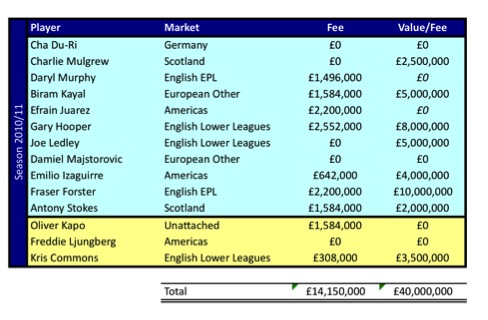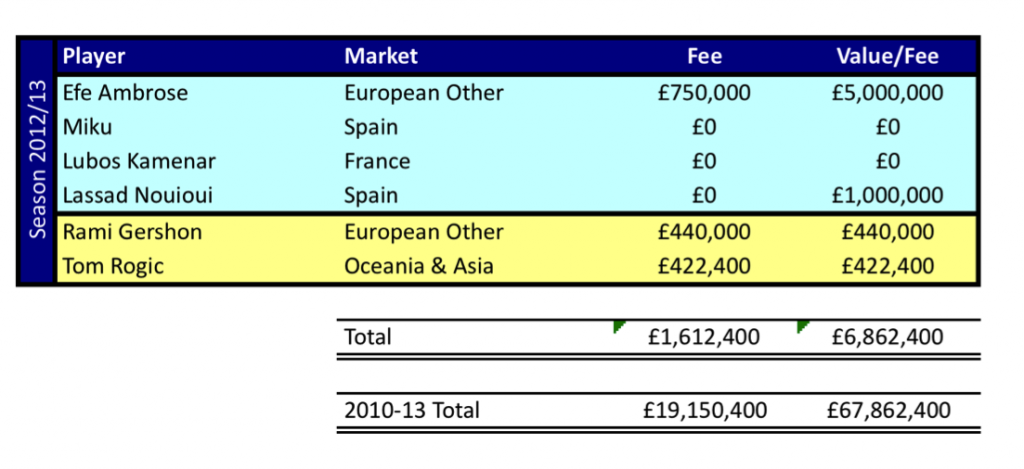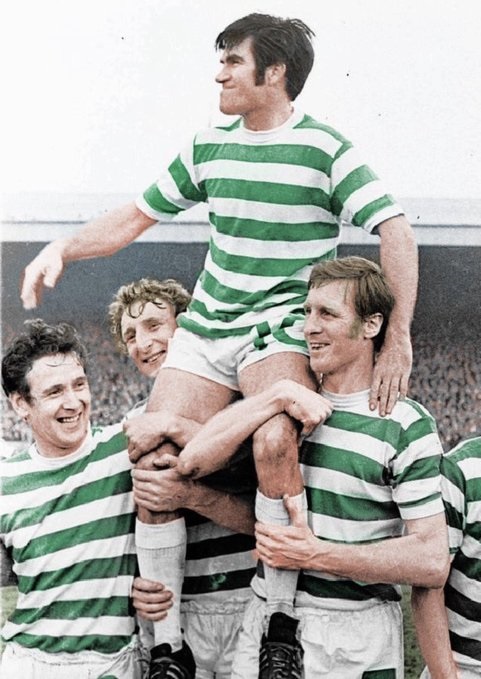Whilst some complain about the EPL price of place impact on the SPL – with Hooper £8m and Zaha £15m being a great example – we should consider that Celtic has exploited this same phenomena extremely well in the last three years.
If you look at our dealings since the shambles of the Mowbray reign and the January transfer window in particular that year, it is clear that we have made a conscious move to try and find more lucrative markets. The club now has an overt policy of seeking to find burgeoning talent with low cost but high potential – both value and ability.
Since 2010/11 21% of our players in – including loans – have come from Europe’s top 5 leagues (EPL, La Liga, Lique 1, Bundesliga and Serie A). Contrast that with with Mowbray’s 42% in his year in charge.
In 2010/11, 3 players came from Europe’s premier leagues; Forster initially on loan for a couple of seasons before we forked out in 2012 for his services. However, the real successes from the periods across the two transfer windows in Lennon’s first season came from the English lower leagues. Hooper, Ledley and Commons are absolutely key members of the squad today.
Also successful in this period were the signings of Izaguirre, Kayal, Stokes, Mulgrew and Majstorovic. Du Ri did a good job for us as well.
In many ways you could argue that this was one of the most successful years of transfer dealings in Celtic’s recent history. We spent £14m and the value of the players brought in is around £40m. In addition, of the 14 players signed in 2010/11 I would regard 10 of the 14 players signed as being at least acceptable, and in some cases outstanding acquisitions.
Only Murphy, Ljungberg, Kapo and Juarez could be regarded as failures and I am sure that most Celtic fans would agree that there is a great deal of regret over Juarez as he could/should have been a star. Interestingly, the other three players all consolidate the folly of buying players based on years old EPL perceptions. We’ve not been playing in that sandpit since.
Without a doubt this transfer period proved pivotal in consolidating Celtic’s belief in the current transfer strategy.

People talk a lot about trusting Park and Lennon et al when it comes to bringing in new players and 2010/11 consolidated that view.
The following season saw us have more modest rake around the transfer market. Bear in mind 10 out 14 players in the previous season were key first team members, the need to do heaps of business had dissipated and rather it was about adding to the squad instead of trying build one from scratch. Therefore, it was understandable Celtic was less active in this window.
Five players arrived in the summer window with mixed success. Interestingly, two English lower league signings have again proven successful with Adam Matthews and Kelvin Wilson coming in on frees (albeit we had to pay development fees for Matthews as was under-23). El-Kaddori’s loan from Dynamo Kiev was less successful albeit he did score at Ibrox with the kind of grass-cutter and McGregor faux-pas combo that seemed to befit the Moroccan’s time with the club. The other summer signing was the much maligned Mo Bangura who, whilst still on our books, has no real future at the club it would seem.
The star signing of 2011/12 is undoubtedly the man mountain that is Victor Wanyama. Whilst Kelvin Wilson took 18 months to settle in and convince the support, it was immediately obvious that the Kenyan was a superstar in the making. As Hector Bandido likes to remind us, all major clubs in Europe have registered an interest with Celtic for the big man. My £10m estimate is perhaps conservative with this in mind.
The January window saw four players arrive. Blackman and Rabui came in on frees. Broznek came in from Trabsponzor on a loan deal costing the club almost £300k. The Pole’s highlight was being replaced by Tony Watt at Motherwell the day the youngster announced his arrival in the first team squad with 2 quickfire goals on his debut.
The final player arriving in 2011/12 was Mikael Lustig and the Swede has really begun to win over the fans and talks of a big money move to Russia underlines why Lennon was right to persist with the Musketeer doppelgänger.
None of the 9 signings came from Europe’s big leagues.

So, 2011/12 saw 9 players in and 5 go on to be a success. We spent just shy of £4m and have players valued in the region of £21m. This makes the first two seasons under Lennon’s tenure spectacularly successful in respect to transfer deals. £18m was spent in outgoings and the value of the incoming players c. £61m. And this doesn’t even begin to account for movements of players transferred out who were signed prior to Lennon’s arrival.
Combined 23 players came in and 15 played key roles between coming in to the club and the present day. This is a success rate of 2/3. When you consider we are signing players from unproven leagues, based on a potential and looking to bleed them in the kickfest of the SPL, this is a fantastic hit rate.
But, and there is a but, the January signings have so far proven much less value than the work done in the summer. Coincidence? I don’t think so.
Over the first two seasons 7 players came into the club in Januarys. Only 2 could be regarded as successes: Commons and Lustig. So, of the 8 players who have failed to make a mark at Celtic since Lennon came in, 5 came in January. This makes our summer success rate an even more impressive 12/16 or 75%.
All of which supports the theory that January signings are not always the most likely to be a hit.
As is obvious when you consider the journey from 2010 to 2012 in respect to the signings discussed previously establishing themselves in the team, 2012-13 has seen more modest transfer dealings again.
Only 4 players arrived in the summer and only Ambrose was a straightforward purchase. We got Lassad on a free and he looks as if he is starting to settle, whilst the aforementioned Ambrose had settled before he got on the plane to Glasgow. The performances against Barcelona in particular were colossal.
Miku has come in on loan with an option to buy. I doubt this will be exercised and Kamenar has come and gone with the fanfare of the pensioners’ bingo night.

So, three players come from Spain and France and only one is mildly successful and shows potential to kick on (NB: I know Lassad in Spain’s Segundo but DLC were promoted and he refused an offer to stay). Meanwhile, another signing from Europe’s minor leagues, and again Israel, has been sterling.
Did we dabble in Spain and France with the ECL in mind? Probably. Did we bring Kamenar in with a view to seeing if he was fit to replace Forster? Probably. Have we done it prudently and without putting any pressure on the club? Absolutely.
It is interesting to see us back in the ‘European other’ market with Gershon and plundering a new market for the highly-rated Rogic. It can be easy for new managers and scouts to blow out with all the good signings early on and then struggle to replicate these successes as they have to delve deeper time and again. However, when you look at our club, since 2010 we’ve spent £19m and have players valued at about £67m. All of these players are still at the club as well.
One obvious conclusions to take from this is that our business is best done in the summer. In and out.
We have had excellent success in this period and factors such as taking our time, scouting well, getting a pre-season with the new players, coming in at a less-pressured part of the season (not every game is must-win) and when the conditions overhead and underfoot are more favourable for newcomers.
And signing players from Europe’s big five leagues ain’t for us.
Aside from Forster we’ve had very little value out of players from Europe’s big five leagues. Lassad and Du Ri have been OK and the triumvirate of ex-EPL players signed in 2010 proves that we’re better catching players on the way up than standing arms wide open to get them on the way down.
If players in these leagues are doing well that will generally be known. Yes, you might get a Michu or a Forster but that truly is needle-in-a-haystack stuff. Football is such a global game now and so long as we continue to cast our net far and wide we will get success. We’ve probably exhausted the English lower leagues as much as we can for the time being, albeit it has been our most fruitful pickings.
If we can continue with the current strategy and combine it with really getting the best out of our youth set-up then the future should remain bright.
(source of transfer fees: http://www.transfermarkt.co.uk/)

Great work by everyone at the club. If our squad is worth that much, what is John Park worth? This model has been perfected by Porto and other clubs are catching on–notably Napoli and Ajax. As much as it sucks to be considered a stepping stone, I think we’re resigned to this fate until the EPL bubble bursts. A job well done to everyone at the club. The future’s bright…it’s green and white! Hail Hail
John Park deserves lots of credit but the real challenge is creating and system and culture that isn’t reliant on individuals to bring the right players in. You would hope the club recognises this and the team of scouts working to Park are as adept but less lauded. He can’t be identifying every player on his own, although I expect he would form part of a screening process before any flights are booked for Lenny to go and see a player in the flesh.
Bedford
Congratulations on a very informative and interesting piece of work. It proves that things are not just on course on the playing field but potentially “booming” in the marketplace. I have never had total confidence in the swallow summer theory but your data proves that benefits or profitably should not be gauged from a single buying spree. The overall picture is what counts. In fact your detailed charts provide the confidence that, by sticking to current policy, we should cope comfortably with the flops if we do well with the flips. Lenny and co. seem to be right on the ball with this and should the financial returns remain steady or even rise, the future of the club is truly bright, onwards and upwards in green and white. Great stuff.
H H
The chicken sacrifices must be working. I have had 5 replies on the trot posted. Praise to the Bampot Gods!
It’s a stay of execution for you. Any more talk of s3xtoys and you’re banned again…
Out of the 11 forward thinking player signed since 10/11 i can only see one that has been a success.
The thought that he will go as Neil will not put his wage on a par with Brown, just doesn’t ring true after his contribution to the team.
When you look at the lists above to see the millions that has been wasted on trying to find decent goalscorers.
To lose the best we found for an extra few grand a week seem strange to me.
Anyway, in Neil we trust
HH
Very good point (albeit you may add Watt to the list in time). Midfielders have been particularly successful.
If Efe Ambrose is worth twice what Charlie Mulgrew is then I’ve not got a clue about football.
Clearly you have valued Mulgrew less because he is Scottish.
Jock – thanks for commenting. I take your point. My main consideration when guessing the value was ‘what would they cash rich arseholes in England pay’ and I think they would pay more for Ambrose than Mulgrew for a variety of reasons.
Doesn’t mean I agree. I am working on an article to expand upon the price of place concept I hint at early in the article that shows how illogical considerations add millions to price of players (see Andy Carroll for more details).
Very good article BF. well done! Some really pertinent analysis.
Have to say though, January’s are just not the same without a Robbie Keane rumour………!
I heard he was having a pint in the Sarry Heid last night before taking the mic at Baird’s. You never know.
Great article mate. Some very articulate points in there. Did you leave out Tony Watt on purpose (signed as a youth team player)?
Also while i realise you were only focusing on players purchased, I think you should also highlight two important facts to paint the complete picture since Lenny arrived.
1. As you mentioned above this doesn’t take into account player sales in this period. By my reckoning we have received approximately 25 million from the sale of 11 players (Fortune 2.5m, Sheridan 0.3m, Crosas 0.3m, Hooiveld 0.5m, Rasmussen 0.3m, Ki 6.1m, Maloney 1m, Juarez 0.5m, McGeady 9.5m, Boruc 2m and McManus 1.5m)
2. Five first team players remain from pre Lennon era (Brown 5m, Samaras 4m, Zaluska 0.5m, Forrest 5m and Rogne 0.5m). Their values should be added to the 67m total you highlighted above.
Overall, the last 3 years have been incredibly successful from an adding market value to the squad point of view. We have received more money than we spent on transfers while increasing the value and standard of player in the squad.
Yes, I did leave Watt (and other youth players out) in order to focus in on players recruited for first team football. Don’t disagree with your point about the rest of the squad as well.
Working on another article to look at the reality of transfer values.
Cheers, BF
Great article.. But ambrose is not a five million pound player.. I like him, but no one would pay that for him so no point totting that up on a purchase performance balance sheet…
Not that I’m still bitter, but the one January non-signing that still rankles is Fletcher for £4m – he’s since been sold for £12m, which O’Neill reckons is a bargain, and would have won us the league that season too.
Good work BF but I think you’ve been on the same accountancy course as Chuckie Verde.
Mo Bangura valued at £500,000?
I think we’ll need to pay a sight more than that to get shot of him.
Excellent article JB and one that puts 95% of the mainstream media to shame. It would appear to me that the key for the future is not holding on to the likes of hooper and wanyama, but the team that John Park heads up. I appreciate as you point out he doesn’t do it all himself but he would be instrumental in putting the current infrastructure in place and my only hope is that Celtic pay these guys enough not be tempted elsewhere. Sometine as fans we lose sight of how far the club has come particularly after bad days like yesterday, however the future is bright and if we keep picking up gems like mentioned above we will dominate for years to come
Cheers Skoosh!
Really good article, which helped me indulge my inner (and outer) geek!
I am still sore after yesterday, but please tell me we played nothing for Kapo, never mind £1.5m?
Pure and utter cut and paste typo there Tony. Thanks for spotting!
While I agree it has a success I would label the value attached to our players as optimistic
If Hooper is really labelled as a 6-8 million player I dread to think what EPL teams think they can pay for others.
Eh… weren’t we just humped by St Mirren?